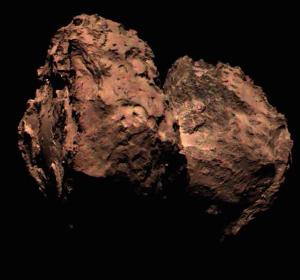Blog
A Comet’s Tale
11 December 2014
 Rosetta/ESA
Rosetta/ESAResults are starting to come in from the Rosetta mission, including a new article in Science on the composition of water on the comet 67P/C-G.1 The results support the idea that Earth’s water didn’t come from cometary bombardments.
The origin of Earth’s water has been a matter of some debate. The traditional view is that early Earth was too hot to retain its primordial water, so our planet was later wetted by cometary impacts during the late heavy bombardment period. It seems reasonable if you imagine comets as dusty snowballs. But as we now know, comets are more like snowy dustballs. And while asteroids are often thought of as dry rocks, they actually contain a great deal of water embedded in their minerals. So Earth could have gotten water from either meteor or comet impacts (or both).
We can actually determine the origin of Earth’s water by looking at trace isotopes within it. Typical water consists of two parts hydrogen to one part oxygen, hence H2O. But there are other variations such as D2O, which is two parts deuterium instead. The ratio of these two varieties of water (known as the D/H ratio) can tell us about the water’s origin. The D/H ratio found in water-rich meteorites is fairly consistent, and it is similar to the ratio of Earth’s water. That would indicate that our water came from asteroids, not comets.
In this new work, the authors measured the D/H ratio of water vented from 67P, and found it was nearly four times higher than Earth levels. This means that our water most definitely did not come from this kind of comet. Comet 67P is part of the Jupiter family of comets. Observations of cometary tails from other Jupiter family comets have given similar results, but this new result is much more accurate.
While this excludes one family of comet, it is possible that other comets might have contributed to Earth’s water. But since periodic comets such as 67P once originated from the same Oort cloud as other comets, that doesn’t seem likely.
Altwegg, Kathrin, et al. “67P/Churyumov-Gerasimenko, a Jupiter family comet with a high D/H ratio.” Science 347.6220 (2015). ↩︎